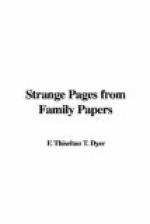At Broughton Castle there is a curiously designed room, which, at one time or another, has attracted considerable attention. According to Lord Nugent, in his “Memorials of Hampden,” this room is “so contrived, by being surrounded by thick stone walls, and casemated, that no sound from within can be heard. The chamber appears to have been built about the time of King John, and is reported, on very doubtful grounds of tradition, to have been the room used for the sittings of the Puritans.” And, he adds: “It seems an odd fancy, although a very prevailing one, to suppose that wise men, employed in capital matters of state, must needs choose the most mysterious and suspicious retirements for consultation, instead of the safer and less remarkable expedient of a walk in the open fields.” It was probably in this room that the secret meetings of Hampden and his confederates were held, which Anthony a Wood thus describes: “Several years before the Civil War began, Lord Sage, being looked upon as the godfather of that party, had meetings of them in his house at Broughton, where was a room and passage thereunto, which his servants were prohibited to come near. And when they were of a complete number, there would be a great noise and talkings heard among them, to the admiration of those that lived in the house, yet never could they discern their lord’s companions.”
Amongst other secret rooms which have their historical associations, are those at Hendlip Hall, near Worcester. This famous residence—which has scarcely a room that is not provided with some means of escape—is commonly reported to have been built by John Abingdon in the reign of Queen Elizabeth, this personage having been a zealous partisan of Mary Queen of Scots. It was here also, under the care of Mr. and Mrs. Abingdon, that Father Garnet was concealed for several weeks in the winter of 1605-6, but who eventually paid the penalty of his guilty knowledge of the Gunpowder Plot. A hollow in the wall of Mrs. Abingdon’s bedroom was covered up, and there was a narrow crevice into which a reed was laid, so that soup and wine could be passed by her into the recess, without the fact being noticed from any other room. But the Government, suspecting that some of the Gunpowder Conspirators were concealed at Hendlip Hall, sent Sir Henry Bromley,




